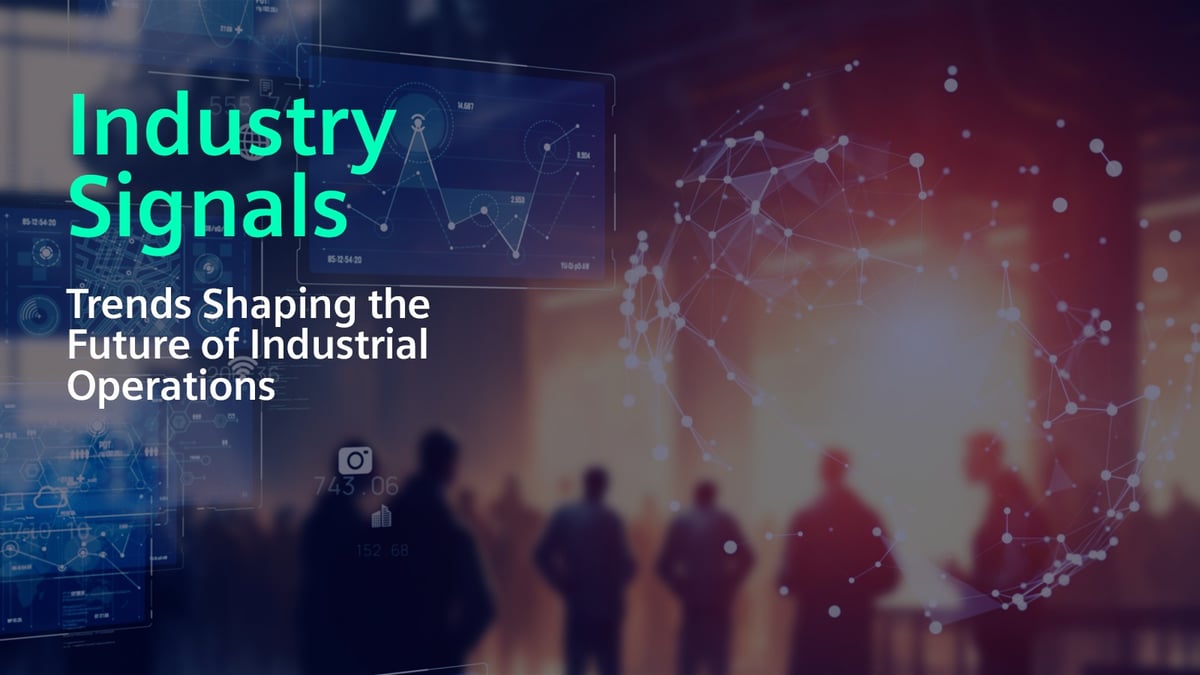Industrial Metaverse
June 24, 2025
Industry Signals - June 24, 2025: Unlocking the Industrial Metaverse & Accelerating Digital Transformation Across Industries

# AI
# Automation
# Data Centers
# Digital Manufacturing
# Digital Transformation
# Digital Twin
# Factory of the Future
# Industrial AI
# Industrial Metaverse
# Innovation
# Key Trends
# Siemens Xcelerator
# Smart Manufacturing
# Smart Cities
# Supply Chain
# Sustainability
The Industrial Metaverse is emerging as a collaborative nexus, where digital twins, AI, and real-time data unite partners across the value chain to accelerate innovation, resilience, and sustainable growth.

Industry Signals

Welcome to Industry Signals. In this issue, we explore the Industrial Metaverse, a convergence of advanced digital simulations, AI-driven analytics, immersive interactions, and synchronized digital twins rapidly transforming industrial operations.
The insights in this issue aim to separate the signal from the noise, moving beyond the amplitude of the hype/despair cycle of consumer metaverse hardware and applications. The Industrial Metaverse is already delivering tangible outcomes, transforming theoretical digital concepts into operational realities, and achieving significant leaps in innovation, efficiency, and collaboration.
Inside, you'll discover critical insights from recent analyses:
- Boston Consulting Group's influential report, "The Transformative Impact of the Industrial Metaverse," outlines the practical steps and strategies manufacturers can adopt.
- MIT Technology Review Insights' own detailed examination, "Bridging Worlds," demonstrates scalable use cases and clear adoption frameworks for industry leaders.
- Capgemini’s structured "Industrial Metaverse Playbook," emphasizing incremental, measurable pathways for implementation.
- S&P Global’s thorough exploration of adoption maturity, digital twin integration, and effective methods for overcoming technological barriers.
These insights highlight the real-world implications and opportunities the Industrial Metaverse presents today, challenging leaders to rethink their competitive strategies and operational processes.

BCG’s Industrial Metaverse Transformative Impact White Paper: Unlocking Four Pillars of Manufacturing 4.0+

Source: Boston Consulting Group | Published: 2025
BCG’s 2025 white paper "The Transformative Impact of the Industrial Metaverse" outlines how an integrated, persistent digital platform, melding IT and OT, represents a paradigm shift in manufacturing. It defines the industrial metaverse as a live, bidirectional digital-physical twin ecosystem combining IIoT, cloud/edge computing, AI (including generative AI), AR/VR, robotics, and open standards. Anchoring development in four key domains (engineering, simulation, automation & robotics, and operations), the report highlights quantifiable benefits and offers a roadmap for scaling digital transformation from isolated pilots to full lifecycle optimization.
1. Engineering: “Born in Simulation”
Digital twins act as the ultimate source of truth, enabling seamless collaboration across mechanical, electrical, and software engineering disciplines.
- Outcomes: ~30% efficiency boost in factory planning by using photorealistic simulation, collaboration engines, and open standards like OpenUSD
- Engineering silos vanish as virtual-first design becomes standard practice.
2. Simulation: Synthetic Data Supercharges Quality
High-fidelity simulations generate synthetic datasets essential for AI training, eliminating reliance on costly physical prototypes.
- Results: Up to 40% reduction in cost of poor quality (COPQ)
- Digital-first validation dramatically improves time-to-market, cutting waste and enhancing product quality.
3. Automation & Robotics: From Static to Cognitive
“Embodied AI” integrates generative AI, IIoT, physics models, and robotics enabling adaptive, human-like actions in dynamic environments.
- Benefit: ~25 % reduction in conversion costs by automating versatile handling tasks
- Next-gen robotics leap beyond repetitive jobs to handle variability using AI-enabled adaptability.
4. Operations: AI-Powered Factory Intelligence
Generative AI and factory ontologies leverage real-time mirror-models of operations, allowing context-rich decision support.
- Impact: Up to 21% productivity uplift in operations
- Operations shift from reactive monitoring to proactive optimization driven by AI reasoning.
5. Convergence at Scale: From Pilots to Sustainable Platforms
The metaverse isn’t a standalone technology—it’s the convergence of IIoT, cloud, AI, XR, digital twins, open standards, and accelerated computing. Yet only ~26% of firms have scaled AI beyond pilot phases, highlighting a strategic gap.
- Companies need systemic integration, governance, and a "metaverse mission-control" to unlock convergence effects and embed digital continuity end-to-end.
The BCG Industrial Metaverse report frames a clear evolution path: from fragmented digital applications to a cohesive, virtuous lifecycle loop: design in simulation → train with synthetic data → operate with AI-informed twins → scale across factory networks. Organizations that master this convergence become agile, efficient, sustainable, and resilient.

MIT Technology Review Insights on Bridging Worlds: The Transformative Convergence of Digital Replicas and Complex Industries

The MIT Technology Review Insights white paper positions the industrial metaverse as a transformative convergence of digital twins, AI/ML, XR, blockchain, cloud/edge computing, IoT, and 5G‑6G networks. It explores how immersive, synchronized digital replicas of complex physical systems can revolutionize engineering, operations, sustainability, and workforce engagement. The report outlines essential enablers like interoperability, open standards, ecosystems and offers a practical roadmap for unlocking industrial metaverse value.
1. Industrial Metaverse Defined: Immersive, Interactive, Persistent
The Industrial Metaverse offers synchronized digital reflections of machines, factories, cities, and transport systems, enabling real-time simulation and decision-making.
- Core components include digital twins, AI/ML, XR, blockchain, and cloud-edge computing.
- Described by Siemens leaders as "immersive... collaborative in real-time; open... trusted by individuals and businesses."
- This isn't just virtual reality. It's a trusted, digital-first plane of industrial engagement.
2. Digital Twins as the Central Pillar
Digital twins integrate real-time sensor data, physics-based modeling, and AI-guided simulation to mimic real-world assets across their lifecycle.
- They form the "active interface" in the real-digital feedback loop, enabling simulation-informed design, testing, and operations.
- The metaverse’s power lies not in XR alone, but in data-rich, AI-enhanced twins that drive continuous optimization.
3. Purpose-Driven Use Cases Deliver Measurable Value
Use cases include virtual commissioning, connected-worker AR support, remote operations, predictive maintenance, and XR-enabled training.
- These are already deployed, delivering quantifiable gains in efficiency, quality, and worker safety.
- The industrial metaverse isn’t speculative. It's pragmatic and driving ROI today.
4. Ecosystems & Interoperability: The Strategic Imperative
Industry partners stress open standards (e.g., Universal Scene Description / USD) and APIs as key to avoid vendor lock-in.
- The afterword emphasizes alliances (e.g. Open USD Alliance, Metaverse Standards Forum) to create connected, multi‑vendor metaverse environments.
- Interoperability across vendors and platforms isn't optional. It's fundamental.
5. Roadmap to Scale: From Pilots to Virtual Futures
The report champions a guided scaling approach: begin with targeted use cases, define clear objectives, empower capability-building, and build partnerships across ecosystems.
- It advocates fostering internal agility and external ecosystem readiness to assemble system-wide industrial metaverses.
- Industrial metaverse adoption is an evolutionary journey, requiring strategic experimentation, governance, and collaboration.
MIT’s “Emergent Industrial Metaverse” offers both vision and execution: immersive digital twins, AI-enhanced simulation, interoperable ecosystems, and scalable deployment roadmaps. It affirms the industrial metaverse as a near-term, value-driving platform: one that transforms how industries design, operate, and innovate, while embedding sustainability and workforce transformation into its core.

Catalyzing Industry 4.0+: A Capgemini Industrial Metaverse Playbook

Capgemini’s April 2025 Industrial Metaverse Playbook positions the industrial metaverse as a pragmatic, structured accelerator for Intelligent Industry transformation. Targeted at CXOs and technology leaders, it outlines how to converge existing digital initiatives like digital twins, AI/ML, IIoT, edge computing, and XR into immersive, value-driven platforms. The playbook emphasizes an incremental, use-case-first roadmap that adapts to company maturity levels and leverages a robust ecosystem to deliver rapid cost savings (~13%), enhanced efficiency, sustainability, and resilience.
1. Pragmatic Roadmap: Build on What Exists
The industrial metaverse is designed not as a futuristic leap, but as an evolutionary extension of current digital transformation initiatives.
- Modular deployment tailored to brownfield/greenfield setups ensures quick, measurable impact at each stage.
- Starting small with clear KPIs enables leadership buy-in and reduces integration risk.
2. Realized Value: Quantifiable Operational & ESG Benefits
Early adopters report ~13% cost reductions across industrial metaverse applications, with case studies from Equinor (50% reduced offshore hours) and BMW (full lifecycle digital vehicles).
- Sustainability gains, such as 15–20% energy savings and lower CO₂, are substantive and measurable.
- Industrial Metaverse delivers dual value: bottom-line efficiency and green performance.
3. Enhanced Workforce Capabilities & Experience
- Immersive technologies (AR/VR/XR) enable enriched training, remote collaboration, and safer operations, making roles more attractive while bridging talent gaps.
- Human-centric metaverse interactions are boosting both productivity and employee well-being.
4. Core Pillars: Intelligence, Continuity & Agents
Anchored in Capgemini’s Intelligent Industry framework, the industrial metaverse spans lifecycle pillars: Products & Systems, Operations, and Support & Services.
- Digital continuity and AI-driven agents power transformation: agents automate workflows, deliver real-time decisions, and support smart advisors across processes.
- The industrial metaverse extends beyond visualization. It orchestrates data, AI, and digital twins into an actionable enterprise engine.
5. Sustainability & Resilience at Scale
The industrial metaverse reduces physical asset dependency, minimizes waste, optimizes resource use, and strengthens supply chain adaptability.
- Environmental impact becomes a strategic feature embedded within operational excellence, not an afterthought.
Capgemini’s Industrial Metaverse Playbook is a call to action: evolve today’s digital investments into immersive, interoperable platforms that drive measurable value across efficiency, sustainability, employee experience, and supply chain resilience. By deploying iteratively, leveraging AI agents and digital continuity, and focusing on purpose-driven use cases, organizations can transcend Industry 4.0, creating a foundation for lasting competitive advantage.

Driving Industrial Maturity: Insights from S&P Global’s “Industrial Metaverse Research Study: Technology”

The S&P Industrial Metaverse Research study surveyed 907 senior decision-makers globally to evaluate the current state of the industrial metaverse from a technology standpoint. It benchmarks how organizations at different maturity levels (Leaders, Challengers, Explorers, Observers) are integrating and scaling use cases across the value chain, highlighting real-world adoption, digital twin centrality, investment trends, and major technical enablers and challenges.
1. Surge in Investment and Adoption
The industrial metaverse is transitioning from experimentation to scaling, backed by strong financial commitment.
- 81% of companies are using, piloting, or planning metaverse applications, with 62% increasing investments in 2024
- Top-tier companies in North America (23% leaders), Europe (19%), and Asia-Pacific (15%) lead the charge.
2. High-Impact Use Cases Gain Momentum
Core use cases like R&D innovation, manufacturing process planning, predictive maintenance, remote operations, and workplace safety have leading adoption and measurable ROI.
- These are classified as “high synchronicity, high data-sharing” applications, indicative of real-time, collaborative engagement.
- Use cases driving significant operational value are becoming standard across industries.
3. Digital Twins as the Critical Backbone
Organizations with deeper digital twin integration deploy significantly more metaverse applications—unified twins enable synchronized data environments.
- Leaders aim to consolidate thousands of siloed twins into centrally governed sets (e.g. 5–6 per division by 2028).
- Strong digital twin strategies unlock system-wide visibility and industrial metaverse scale.
4. Technology Stratified by Maturity Levels
The study segments companies: Leaders have mature digital transformation and ≥10 live metaverse use cases; Challengers/Explorers pursue departmental PoCs with less cohesion; Observers are mostly pre-adoption.
- Digital maturity is necessary but not sufficient. Enterprise-wide governance and culture are equally critical.
- Integration and organizational alignment are what differentiate successful adopters from laggards.
5. Technical Hurdles and Partnering Strategies
Companies face major technical barriers: interoperability, real-time data orchestration, legacy system integration, and talent shortages.
- Leaders increasingly rely on hybrid ecosystems (partnering with digital twin vendors, AI specialists, and cloud/edge providers) to manage complexity.
- Collaborative ecosystems and open standards are essential to overcoming technical fragmentation.
The “Industrial Metaverse Research Study: Technology” confirms that the industrial metaverse is no longer theoretical. It’s delivering tangible ROI through digital twins, real-time collaboration, and immersive use cases. However, achieving scale demands strategic investment, governance, digital twin consolidation, and ecosystem partnerships. Organizations that mature across these dimensions will lead the next wave of digital-first industry.
Looking Ahead
As the Industrial Metaverse evolves, leading technology providers and industrial enterprises are increasingly collaborating to build a robust, interoperable digital ecosystem. At Siemens, through initiatives such as our integration with NVIDIA’s Omniverse and our open Xcelerator platform, we're committed to pushing boundaries to enhance operational efficiency, sustainability, and resilience. Curious how your business fits into this digital future? Take our free assessment to gauge your readiness.

That’s a wrap for this edition of Industry Signals.
Have a report, use case, or event you'd like to see featured in an upcoming issue? Send a note via PM. We’re always looking to spotlight what’s shaping the future of industry and find recommendations from the Xcelerator Community especially valuable. Your insights and experiences continually shape Industry Signals.
— Industry Signals Community Editor
1
Comments (0)
Popular
Dive in
Related
Blog
Industry Signals - June 10, 2025: Technology Convergence and the Key Role of Digital Twins
By Industry Signals • Jun 9th, 2025 • Views 232
Blog
Industry Signals – September 30, 2025: Digital Innovation in Aerospace and Defense
Sep 30th, 2025 • Views 32
Blog
Industry Signals – October 7, 2025: How Industrial Leaders Are Rewiring for AI
By Industry Signals • Oct 7th, 2025 • Views 82
6:27
video
Merging the Digital and Real Worlds together in an Industrial Metaverse Experience
Apr 4th, 2025 • Views 255
Blog
Industry Signals - June 10, 2025: Technology Convergence and the Key Role of Digital Twins
By Industry Signals • Jun 9th, 2025 • Views 232
Blog
Industry Signals – October 7, 2025: How Industrial Leaders Are Rewiring for AI
By Industry Signals • Oct 7th, 2025 • Views 82
6:27
video
Merging the Digital and Real Worlds together in an Industrial Metaverse Experience
Apr 4th, 2025 • Views 255
Blog
Industry Signals – September 30, 2025: Digital Innovation in Aerospace and Defense
Sep 30th, 2025 • Views 32

